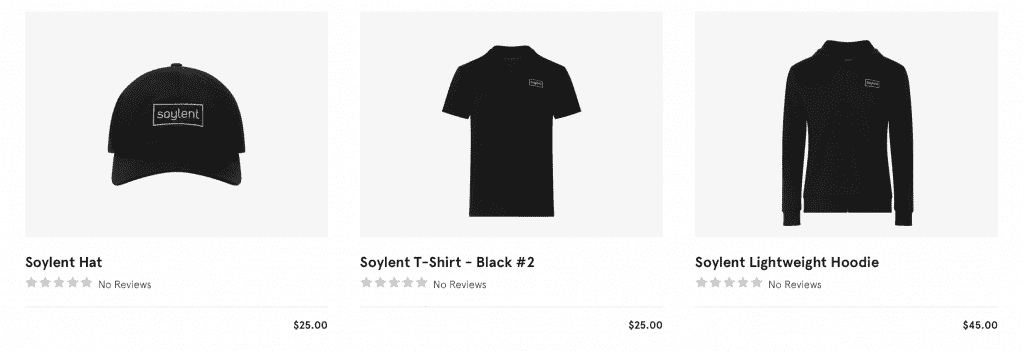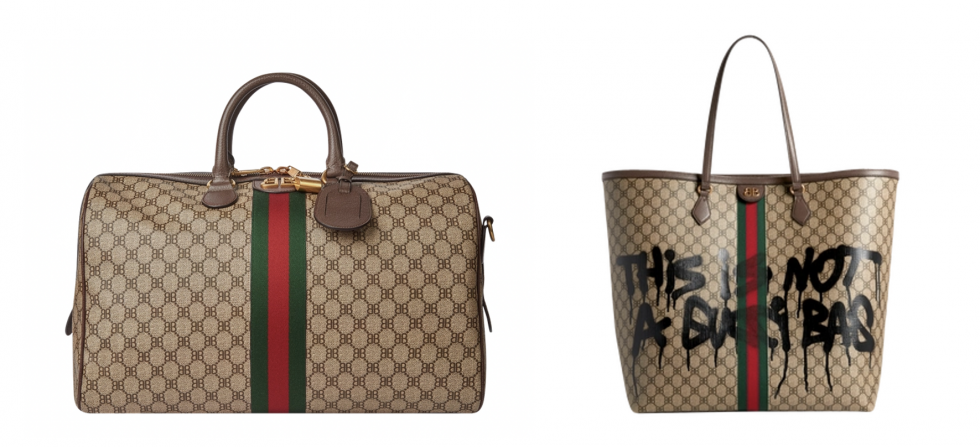SKIMS, the burgeoning loungewear brand of Kim Kardashian, might be eyeing an expansion. Amid the frenzy that was its collaboration with Fendi, one that reportedly generated $1 million in sales in just one minute in November 2021, a couple of trademark applications for registration that counsel for Kardashian’s company quietly filed with the U.S. Patent and Trademark Office in 2020 and 2021, respectively, for “Hims by Skims” for use on “Hats; Leggings; Loungewear; Shapewear; Slippers; Socks; Sweatpants; T-shirts; Underwear; Boxer briefs; Boxer shorts; Hoodies” (in Class 25) and “Retail store services featuring clothing, hats, footwear” (in Class 35) surfaced, and it appear to suggest that a play by the burgeoning brand to enter into the menswear market may be in the works.
Both of Skims’ trademark application for registration were filed on an intent-to-use basis (and comes in lieu of any existing use of the “Hims” aspects of the mark by Kardashian’s brand to date), which very well could mean that a men’s-focused venture called “Hims by Skims” may never actually come into fruition. The name and the potential use of it by Skims is interesting, nonetheless, thanks to the existence of another already-existing brand with a very similar name. That other market occupant is Hims, the telehealth company that was founded in 2017 and is in the business of doling out prescription and over-the-counter drugs, and supplements (namely, of the erectile dysfunction, hair loss, acne, and anxiety kind) online, while also selling personal care products for men.

Sweatpants and supplements – and certainly prescription medication – occupy different segments of the market from one another, but a couple key things stand out (to me, at least) as worth considering in terms of possible confusion between Hims by Skims, and Hims – which filed a trademark application for registration of its own in October 2021 in Class 3 for use on everything from shampoo and cologne to anti-wrinkle cream and facial moisturizers – and thus, prospective pushback should Kim’s Skims make a move towards male consumers.
The Zone of Expansion
The primary point worth considering is the zone of natural expansion, a trademark doctrine that essentially holds that a trademark holder’s existing rights can extend to other areas of the market that it would reasonably be expected to enter. For a recent example of how this works, the organizers of Woodstock argued in the case that they filed in a New York federal court in 2018 that while its main business centers on festival production, the sale of recreational marijuana is within the zone of expansion of such entertainment services, and thus, they are not running afoul of the rights of other entities with federally registered “Woodstock” trademarks for smoking-related items by using the festival’s name on recreational marijuana products. In February, the U.S. Circuit Court of Appeals for the Second Circuit upheld the U.S. District Court for the Southern District of New York’s preliminary injunction in favor of the Woodstock organizers.
More recently, the zone of natural expansion was (seemingly successfully) relied upon by Hermès in its trademark fight against Mason Rothschild over the MetaBirkins NFTs. The zone of expansion issue also came up in the since-resolved squabble between Off-White and S.C. Johnson over their respective OFF trademarks, with the multinational consumer packaged goods and chemicals company arguing that its products and those of Off-White are not only “likely to be marketed and sold to the same consumers, and move in the same channels of trade,” but Off-White’s goods, namely bags in this case, “are in the likely zone of expansion for goods sold by S.C. Johnson under the OFF! marks,” thereby, leading to further potential for confusion.
And still yet, in a zone of expansion-esque argument of its own, Zara managed to successfully put a stop to the registration of the “Zara Tanzania Adventures” trademark for use in Classes 39 (travel and tourism services), 41 (wildlife education and training services, ecology, safaris) and 43 (travel agency and hotel services) back in 2019. At the time, K&L Gates’ Simon Casinader and Daniel Cartmell noted that the Spanish fast fashion brand’s win before the Court of Justice of the European Union “demonstrates the far reaching, evolving nature of fashion brands, and the markets they can operate in and are expanding into.”
The zone of expansion theory could prove a useful tool for Hims – which along with its female-focused counterpart Hers, boasted more than 700,000 subscription members as of May 2022 – should it add merch to its offerings. The company is, after all, in the midst of expansion, unveiling a new app in 2021, complete with a “Member Store” that the San Francisco-based company says will “bring together the entirety of the Hims & Hers product portfolio – from supplements to sleep support and products tackling hair-loss – into one simple and personalized space.”
Since the app is the first step in a larger roll out of “additional educational programs, wellness content, community support, and other services (and presumably, other goods) and given its move to brick-and-mortar by way of a newly-announced partnership with Walgreens, it is not difficult to imagine Hims attempting to bolster its “community” with branded products, such as t-shirts or even underwear (the latter of which is not light-years removed from erectile dysfunction medication) in the same way as so many other buzzy direct-to-consumer companies have done.
One company that comes to mind is Glossier, which got its start exclusively selling cosmetics and has since expanded into apparel and accessories, including branded hoodies, bags, and water bottles. If its pending trademark applications are any indication, Glossier is looking to expand further into the market via vitamins and supplements, as well as home-oriented offerings like candles.
There are countless other examples, as companies continue to blur the lines between traditional offerings and those that can be expected from a modern company catering to brand-happy, community-leaning millennials. Peloton has workout offerings and sells a lot of them; the interactive fitness platform sold 600,000 units of branded apparel in Q4 of 2020. The Ritz Paris teamed up with Frame for a collab of trademark-bearing wares. Shaving company Harry’s expanded beyond razors, and has hats, fanny packs, and boxers currently up for sale on its e-commerce site. Alcohol brand Haus offers up branded tote bags. Even Soylent has merch if you want to proclaim your love for soy-based meal-replacement drinks through branded t-shirts, sweatshirts, and hats.

Against this background and given that just about every buzzy company – from drink-makers to exercise bike companies – is first and foremost a brand (and ideally, an Instagram-friendly one) that happens to also sell products/services, it probably is not a stretch to argue that merch is absolutely within the realm of imaginable expansion for Hims (and also Hers). As for whether anyone would want to wear the name of the company that provides them with acne or anxiety medication is, of course, another matter.
Collaboration >> Confusion
The other key point worth considering here is the role that collaborations – and the emerging adoption of some interesting new examples of co-branding – play when it comes to the issue of potential confusion (i.e., the core element at the heart of a trademark infringement claim). As TFL wrote back in at least 2017, the onslaught of branded collabs that has become the norm for fashion brands and consumer products-makers more broadly has likely made it so that consumers are increasingly susceptible to confusion about the source of goods/services, as sometimes the source can be more than one entity. In other words and in light of the continued reliance by companies on creativity-by-collaboration (as opposed to actual creativity, one might argue), it is entirely likely that any given product in the market is the result of a collaboration and/or that an ever-growing list of brands are engaging in such collaborative efforts, thereby, blurring the line between respective brands’ offerings.
(Burberry actually argued this point in the trademark lawsuit that it filed against Target in 2018, in which its counsel claimed that consumer confusion was likely to abound in connection with the checkered wares being sold by the retail chain due to “Target’s well-publicized history of collaborating with popular brands and fashion designers to promote and sell Target-exclusive limited-edition collections.” In other words, because Target has engaged in a string of collaborations in the past, who is to easily say if something is or is not the product of a collaboration going forward?)
The chance of confusion is heightened by the inter-industry tie-ups that continue to make their way to market with regularity, whether it be co-branded home furnishings from Off-White and Ikea, apparel from Proenza Schouler and Mercedes-Benz, or a cartoon that consists of both Balenciaga wares and the Simpsons. Beyond that, there are the tie-ups between arguably unlikely bedfellows, such as LVMH-owned Fendi and Capri-owned Versace, stalwart jewelry company Tiffany & Co. and hyped streetwear brand Supreme, or loungewear company Skims and high fashion house Fendi.

And still yet, the potential for confusion is increased even more by the fact that a growing number of products are coming to market bearing the mashed-together trademarks of more than one market entity. Fendace, anyone? How about Gucci bags with Balenciaga branding on them? If you are not confused (even for just a minute), there is a chance that you might not be paying close attention.
Ultimately, the reality is that in an effort to consistently create novelty to attract consumers, almost any combination could make for an often-heavily-hyped collaboration. Crocs x Hidden Valley Ranch comes to mind as just one example. At the same time, it seems that far fewer things are being left off the table in terms of what the reasonable zone of expansion for a brand could/should look like. And all the while, trademarks, themselves, are readily taking a wide range of forms – from red zip tie and pink bubble wrap pouches to mashed up marks from different companies (a la Yeezy Gap and Gucci x Balenciaga branding). Taken all together, this could make Hims by Skims – and a whole slew of other examples – a confusing prospect for consumers when it comes to the notion of source.
It will be interesting to see what – if anything – happens if/when Kardashian’s brand actually begins using Hims by Skims in commerce; the USPTO issued a notice of allowance for the mark in May and last month, it approved Skims’ first request for an Extension of Time to File a Statement of Use. Should Hims take action, it would not be the first time that a Kardashian business has faced pushback over a trademark. In fact, Kim was embroiled in a separate trademark tangle over the name for her skincare venture, SKKN and SKKN by Kim, this summer, after filing trademark applications for registration for those names.
UPDATED (Feb. 16, 2023): Skims has abandoned one of the Hims by Skims applications (for use in Class 35) after it received an Office action citing potential confusion with a number of Hims’ registrations. Skims was granted a notice of allowance for the other “Hims by Skims” application (for use in Class 25) but has not yet filed a statement of use.
This article was originally published on Nov. 11, 2021, and has been updated to include additional reporting.











